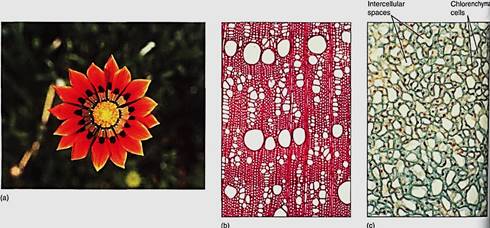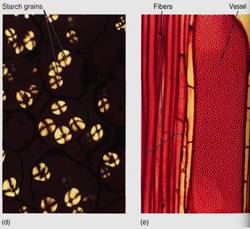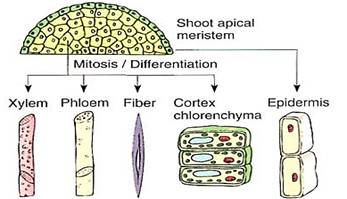


 النبات
النبات
 الحيوان
الحيوان
 الأحياء المجهرية
الأحياء المجهرية
 علم الأمراض
علم الأمراض
 التقانة الإحيائية
التقانة الإحيائية
 التقنية الحيوية المكروبية
التقنية الحيوية المكروبية
 التقنية الحياتية النانوية
التقنية الحياتية النانوية
 علم الأجنة
علم الأجنة
 الأحياء الجزيئي
الأحياء الجزيئي
 علم وظائف الأعضاء
علم وظائف الأعضاء
 الغدد
الغدد
 المضادات الحيوية
المضادات الحيوية| Introuction to Genes and The Genetic Basis of Metabolism and Development |
|
|
|
Read More
Date: 27-10-2016
Date: 2-11-2015
Date: 20-10-2016
|
Introuction to Genes and The Genetic Basis of Metabolism and Development
Plants are composed of numerous types of cells. Each cell type is unique because it has a distinct metabolism, based largely on proteins such as enzymes, microtubules, and membrane proteins. Although all cells carry out a fundamental metabolism involving respiration amino acid synthesis, and so on, some of the reactions in one cell type differ from ta in other cell types. Each cell type may have one or more characteristic types of enzymes or other proteins. For example, enzymes involved in synthesis of flower color pigments are present in petal cells but not in cells of roots, wood, and bark (Fig. 1a).


FIGURE 1:Cell differentiation is controlled by regulating particular genes in each type of cell. (a) These petals have enzymes necessary for the synthesis of pigments. These enzymes are not produced in most of the other cells of the plant, although all cells contain the necessary genes. (b) These wood cells had many enzymes not found in the petal cells of the same plant. During differentiation, each cell type became unique as different genes were activated, different proteins were produced, and their metabolisms diverged into unique pathways (X 200). (c) Chlorenchyma cells differ from other types by having well-developed chloroplasts (X 200). (d) These cells have differentiated such that starch storage and release are the dominant aspects of metabolism. They probably have no unique enzymes: All cells can metabolize starch. Degree of activity of a particular set of proteins is important in differentiation (X 180). (e) These vessels and fibers have similar if not identical metabolisms for synthesis and lignification of walls; they differ primarily in cell shape and pattern of secondary wall deposition. Precise positioning of cellular elements is also critical during differentiation (X 150).
Also, sclerenchyma cells contain all the types of enzymes necessary for producing and lignifying secondary walls, but these enzymes and metabolic pathways are not present in parenchyma cells (Fig. 1b, c, and d).
Cells also differ in shape, again largely owing to differences in their proteins. All tracheids and vessel elements probably have the same enzymes and metabolism £r secondary wall deposition, but the wall can vary (Fig. 15.1e). We believe that wall deposition is guided by a pattern of proteins in the protoplasm, probably a set of microtubules Similarly, many cell divisions occur in precise patterns, so there must be an underlying pattern in the cell that causes the mitotic spindle to have the proper alignment.
The information needed to construct each type of protein is stored in genes, but because an organism grows by mitosis—duplication division—all its cells have identical sets of genes. As each cell differentiates and develops a unique suite of proteins, the underlying developmental process is the differential activation of genes. In the maturing epidermis, genes that code for cutin-synthesizing enzymes are turned on, whereas in other cells they remain turned off (Fig. 2). On the other hand, genes for P-protein remain quiescent in all except phloem cells. Studies of development and morphogenesis examine the mechanisms by which some genes are activated and others are repressed.

FIGURE 15.2:Because all body cells are produced by mitosis, they all have the same genes. Certain basic metabolism genes are probably active in all cells, but specific pathways become active during differentiation, probably because the genes that code for the enzymes of those pathways become active. Once fully mature, the cells may go back to basal metabolism. Epidermal cells often produce cutin only when differentiating, not after maturity. Sieve elements lose their nuclei as part of maturation, and tracheary elements digest away all of their protoplasm; they have no metabolism at all when mature.
During protein synthesis, the correct amino acids must be incorporated in the proper sequence, because this determines both the structure and all other properties of the protein. The cell must contain a source of information that holds the sequence information for all its proteins; this information archive is DNA, deoxyribonucleic acid. DNA is a linear, unbranched polymer composed of four types of deoxynucleotide monomers, usually abbreviated A, T, G, and C (Table 15.1). Once actually polymerized into DNA, the base portion of each nucleotide monomer protrudes as a side group. It is the sequence of nucleotide side groups that is the information needed to synthesize proteins correctly. A gene is each region of DNA that is responsible for coding the amino acid sequence in a particular protein. Each type of protein has its own gene.

Both environment and protoplasm also contain information vitally important for plant growth, morphogenesis, and survival. the environment provides informative cues about season, moisture availability, time for seed germination, time for flowering, and direction of gravity. These environmental and metabolic signals must be converted into chemical messengers that enter the nucleus and interact with genes. If the signals indicate that the cell is to differentiate into a vessel element, all genes that produce enzymes necessary for the synthesis and lignification of a secondary wall must be located and activated. Genes that code for the proteins that guide a particular pattern of wall deposition also must be turned on. Conversely, the cell must be inhibited from undergoing any further cell division; genes involved in mitosis and cytokinesis must be repressed.
Recently, techniques have been developed that permit botanists to locate the genes for many proteins; the genes can then be isolated in vitro and duplicated and their nucleotide sequences revealed. At present our knowledge is still limited, but these techniques of DNA sequence analysis are so powerful that progress is extremely rapid. Similar techniques make it possible to alter the DNA sequence and then insert the gene back into a plant cell. As the cell grows, divides, and differentiates, the altered DNA either produces an altered protein if the coding region was changed or produces the protein at an unusual time or place if its control site was changed. These recombinant DNA techniques, sometimes called genetic engineering, are helping us understand the processes that occur between the perception of a stimulus and the plant's response to that stimulus. In addition, recombinant DNA techniques permit us to change features of plants—for example, making them mete resistant to insects or having seeds and fruits that are more nutritious for us.



|
|
|
|
حمية العقل.. نظام صحي لإطالة شباب دماغك
|
|
|
|
|
|
|
إيرباص تكشف عن نموذج تجريبي من نصف طائرة ونصف هليكوبتر
|
|
|
|
|
|
تعد الأولى من نوعها.. ادارة مستشفى الثقلين للأورام في البصرة تكشف مميزات أجهزة قسم العلاج الإشعاعي
|
|
|
|
بالفيديو: يعد من المشاريع العملاقة والمهمة.. تعرف على الأسباب التي دعت العتبة الحسينية لافتتاح اكاديمية الثقلين للتوحد واضطرابات النمو في البصرة
|
|
|
|
يعد من التحاليل المهمة للكشف المبكر عن عدد من الامراض.. مستشفى تابع للعتبة الحسينية يكشف عن إحصائية فحوصات بروتين (A) الخاصة بالنساء لشهري آذار ونيسان
|
|
|
|
يشمل أكثر من (400) طالبة على شكل دفعات.. العتبة الحسينية تنظم برنامجا لتكريم المتفوقات من ذوات الإعفاء العام في النجف الاشرف
|